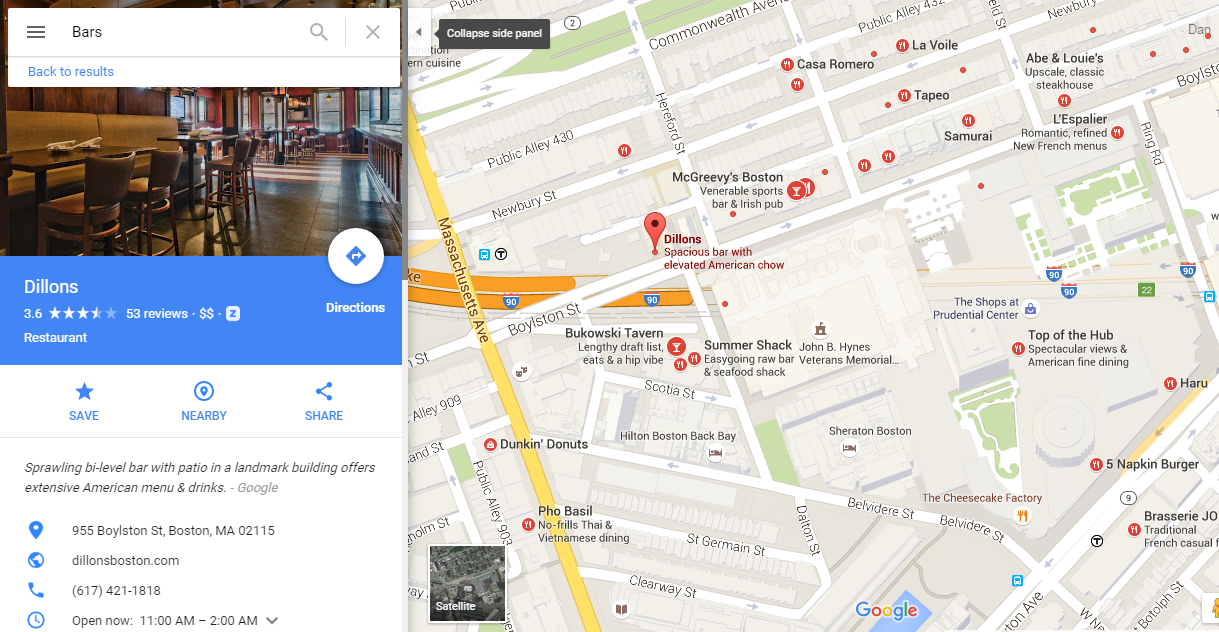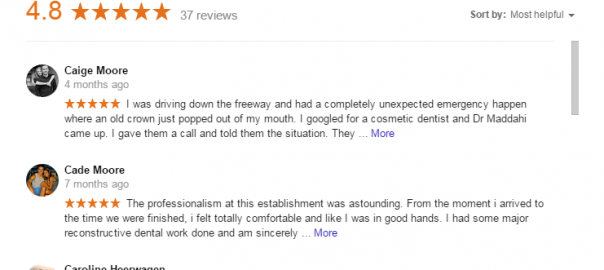Everyone has their favorite Google app, and mine is – without a doubt – Google Maps. Sure, Google Now is incredibly impressive (and getting better all the time, thanks to Google’s artificial intelligence, RankBrain), but Maps is one of the apps that Google has spent the most time refining and improving, and the results speak for themselves.

Although I pride myself on my strong natural sense of direction, I use Google Maps all the time. Where would we be without Google’s omnipresent GPS data to guide us? Probably driving off cliffs or getting lost in fields, if Apple’s attempts to match Google Maps is any indication (yes, I know, it’s better than it was, but it’s still terrible). Google Maps is undoubtedly one of the most useful tools Google has given to the world, but it’s much more than a means of getting around without resorting to folding paper maps (bad) or asking people for directions (worse) – it’s an incredibly powerful marketing tool.
In this post, I’ll walk you through how digital marketers can – and should – be using Google Maps marketing as part of their wider digital marketing strategies. We’ll cover essential features and things you absolutely must be doing, as well as some nifty, lesser known tips and tricks to help your customers find you.
What Is Google Maps Marketing?
In a nutshell, Google Maps marketing is the process of using Google Maps’ functionality to make your business easier to find. Although this can be very useful (and expected) for large companies, it’s even more indispensable for smaller businesses. However, Google Maps marketing isn’t just about visibility – it’s about positioning, and not just that of your store. If used correctly (and strategically), Google Maps can play an important part in your digital marketing strategy.
What’s the Point of Google Maps Marketing?
The ultimate objective of Google Maps marketing is to achieve as high a placement as possible in the local business results listings on the Google Maps results on relevant Google search engine results pages. Let’s take a look at what this means.
Proximity Based Google Maps Results
The first type of Google Maps listing is that based on your physical location. With mobile search volume increasing, this type of search (and Google Maps result) is becoming much more common. If you’ve ever performed a search for a specific type of business from your mobile device, you’ll almost undoubtedly have come across a result like this:

In the example above, I performed a search for “bookstores” and received these results. As you can see, Barnes & Noble has the top spot thanks to its PPC ad, as well as the top organic result (whether this is a result of high search volume, canny SEO, or a rapidly dwindling corporate bookstore market is anyone’s guess). However, the Maps results are what we’re really interested in.
Similarly to the way PPC ads are subject to the ad rank formula and assigned ad positions based on that formula, Google Maps listings are prioritized into positions based on the user’s location, with position “A” being the closest and most prominent. Positions “B” and “C” are also provided, in case I want more options.
You may have experienced results like this yourself. Many mobile users are prompted to search for businesses near them thanks to Google Suggest, especially when searching from their mobile device. The screenshot below shows the same search performed on my Android device with location data tracking enabled:

Depending on a number of variables, some searchers may find that predictive “near me” results are even more prominent than they are in this example. It’s almost as if Google wants us to use Maps to find local businesses!
‘Ranked’ Google Maps Results
Although proximity based Maps results are common, they’re not the only type of results offered by Google Maps. Not every user has location data enabled on their mobile device, and Maps listings are available for virtually any destination on the planet, not only those in the user’s general vicinity. This is when “ranked” Google Maps results are often shown. These results appear on Google Maps searches for businesses of a certain type in a given location. For example, in the figure below, you’ll see Maps results for “dentists” in Beverly Hills, California:

As you can see, Beverly Hills is particularly well served when it comes to dental practitioners (got to keep those pearly whites as white as can be for the cameras, after all), which makes it a highly competitive market for Google Maps marketing results. At the top of the list is Dr. Kourosh Maddahi, who owns a dental practice on North Roxbury Drive that has an average patient rating of 4.8 out of five stars from 37 Google reviews.
Here’s where the “marketing” part of Google Maps marketing comes into play.
In this search, I looked for businesses on the other side of the country (eliminating any possibility of my location factoring into my results), so Google isn’t showing me results closest to me. If you look at the second-highest result in the example above, you’ll notice that Dr. Arthur Glosman’s dental practice is also located on North Roxbury, but has a slightly higher patient rating of 4.9 out of five based on 51 Google reviews, but this result is ranked below Dr. Maddahi’s practice, so Google isn’t ranking these Maps results purely based on customer ratings, either – so what’s going on? The answer lies in how well-optimized your Google My Business listing is, along with some other factors.
What Is Google My Business?
Formerly known as Google Places, Google My Business enables business owners to claim a listing for their business that may appear in Google search results. Virtually any type of business (with the exception of certain more risqué establishments) can claim a Google My Business listing, which will display information that searchers may want to know, such as address, opening hours, and customer ratings.

Image via Google
Google Maps Marketing Optimization Checklist
Although many businesses claim their Google My Business listing, many simply register their business and provide only the most cursory (or worse, incomplete) information. This, unsurprisingly, results in far less visibility and a poorer overall Google Maps ranking. So what can you do? Here’s a checklist to improve and optimize your Google Maps listing for maximum visibility.
Use Complete, USPS-Approved Address Information
Getting your address right might seem like the easiest part of your Google My Business listing, but you’d be surprised by how many businesses get this wrong.

When entering your address into your Google My Business profile, ensure that you use the exact same address information used by the USPS (or applicable postal service where your business operates). This includes room, suite, or subdivision information, a full nine-digit zip code, and anything else that makes your business easier to find. Be sure to check for erroneous spaces and other formatting errors, as even slight mistakes in address formatting can interfere with your Google Maps ranking.
Something else to check is that your address is actually being displayed in your Maps listing in the first place. In your Google My Business settings, there is a checkbox that states whether you would like your address information to be displayed. Barring a few exceptions (for matters of customer privacy or safety, for example), this should almost always be checked. The more data you give Google, the more likely you are to rank more highly in Maps results.
Specify Which Areas You Service
Some businesses have a physical storefront or location, but also serve a wider area – think pizza delivery services or package carriers, for example. If this applies to your business, it’s crucial that you state which areas your business services in your Google My Business profile. This could include the names of nearby towns or cities that you serve, or a geographic radius (in miles or kilometers) from your physical location.

You can (and should) also specify whether you actually serve customers at your business’ primary location. If you do not, you don’t want people turning up at your business expecting to be served when you’re a phone-only company, for example.
Get Your Google My Business Listing Verified
Getting your Google My Business listing verified should be the next item on your to-do list. The verification process can take up to a couple of weeks, as usually Google insists on mailing a postcard with a unique PIN to the physical address listed in your Google My Business profile to confirm verification. Google does allow some businesses to verify ownership via phone.

Check ALL Categories Relevant To Your Business
Many businesses only state their primary category when creating their Google My Business profile, which is a huge optimization opportunity missed. Although you’re required to list your primary category in order to actually create your Google My Business listing, you can (and should) include additional categories that are relevant to your business.

This step is especially important if your company offers a wide range of related services. For example, if you run a digital marketing agency, you might set “Internet marketing” as your primary category, and include SEO, PPC, content marketing, email marketing, and social media advertising as additional categories. The more information you provide Google, the more accurate – and optimized – your Google My Business listing will be.
Optimize Your Introduction
You can think of your Google My Business Introduction as a summary of your company, the products and services you offer, and what sets you apart from the competition. Again, many businesses don’t even bother to take the time to do this, which is another missed optimization opportunity.

Your Introduction should contain everything a prospective customer might need to know about your business, such as what you do, where you are, and why your business is the best. You can insert links to relevant pages on your site in your Introduction, but be wary of link- and keyword-stuffing. Your Introduction may be subject to Google’s editorial standards, so cramming links and keywords into your Introduction is not only a bad, sleazy, black-hat thing to do, it’ll also probably result in a denial from Google. By all means use relevant keywords in your Introduction, but take the time to craft a well-written, compelling Introduction written with searchers in mind.
Going back to our digital marketing agency example above, if you offer a wide range of products or services, consider using a bulleted list rather than including them in your copy. This makes it easier to read, which is a best practice that can help your Introduction resonate more strongly with people searching for your business.
Include (and Optimize) Photos in Your Google My Business Listing
Google Maps is an inherently visual platform that goes beyond the maps themselves. Businesses with listings on Google that include photos are much more appealing than those without, which makes your business stand out, but the inclusion of photos can also be an optimization opportunity.
Take a look at this example of a well-optimized listing for Dillons, a bar just around the corner from WordStream’s offices that’s a perennial favorite with our staff:

See how much nicer the listing looks with that crisp, professional image at the top? This makes Dillons look a much more inviting destination than it would be without images. Users can also scroll down the Google Maps listing to see more pictures of your business, which can be crucially important if ambiance is important to your establishment (as it is with many service-based businesses).
However, including images in your Google My Business listing is about much more than looking pretty – you can also optimize the images themselves to increase your visibility. You can use third-party apps to add metadata to your images, making them easier to find. For example, you might add the following metadata to your images to make them as optimized as possible:
- Physical address / latitude and longitude
- City / geographic location / country tags
- Keywords relevant to your business
- Comments about relevant services offered at your location
- Additional categorization information
Solicit Customer Reviews
Remember how we talked about user reviews in our dental practice example above? It’s unclear to what extent user reviews play a part in the Google Maps search algorithm, but a business with no reviews is almost certainly going to struggle to compete with a business with lots of reviews, so it’s vital that you solicit and include reviews in your Google My Business profile.

It’s worth noting that reviews will not be displayed alongside your Google Maps listing until you have accrued at least five, so be sure to encourage satisfied customers to gush about how great you are. Unfortunately, there isn’t much you can do about negative reviews aside from responding to them according to Google’s guidelines, so it’s important to monitor what people are saying about your business carefully and respond appropriately.
You can also use third-party monitoring tools to keep tabs not only on your business, but competitors’ businesses in Google Maps. Reviews of businesses on Google, Yelp, Yahoo Local and similar services are considered “citations” of a business, which are trackable using media monitoring tools like Mention. You can check how many reviews (or citations) the top-ranked business in Google Maps has, which can give you an idea of the standard and volume of reviews necessary to rank more highly. Citations can function similarly to backlinks – the more citations you have, the more ranking potential your business may have in Google Maps.
As with almost everything relating to Google’s algorithms, it’s impossible to say how important citations and reviews are to your positioning in Google Maps, but if you’ve got a ton of links and positive mentions from sites like Yelp, it can only be a good thing.
Above All, Be Patient
Like other digital marketing optimization efforts, improving your visibility in Google Maps marketing can – and likely will – take time. This means there are no quick hacks, no overnight fixes, no easy way to rise to the top of the pack. Even if you implement all the optimizations above, it may still take a while for your business’ visibility to improve in Google Maps. However, don’t despair. Just stay on top of your optimization efforts, keep your information and profile current, and focus on what really matters – taking care of your customers.
Digital & Social Articles on Business 2 Community(122)








